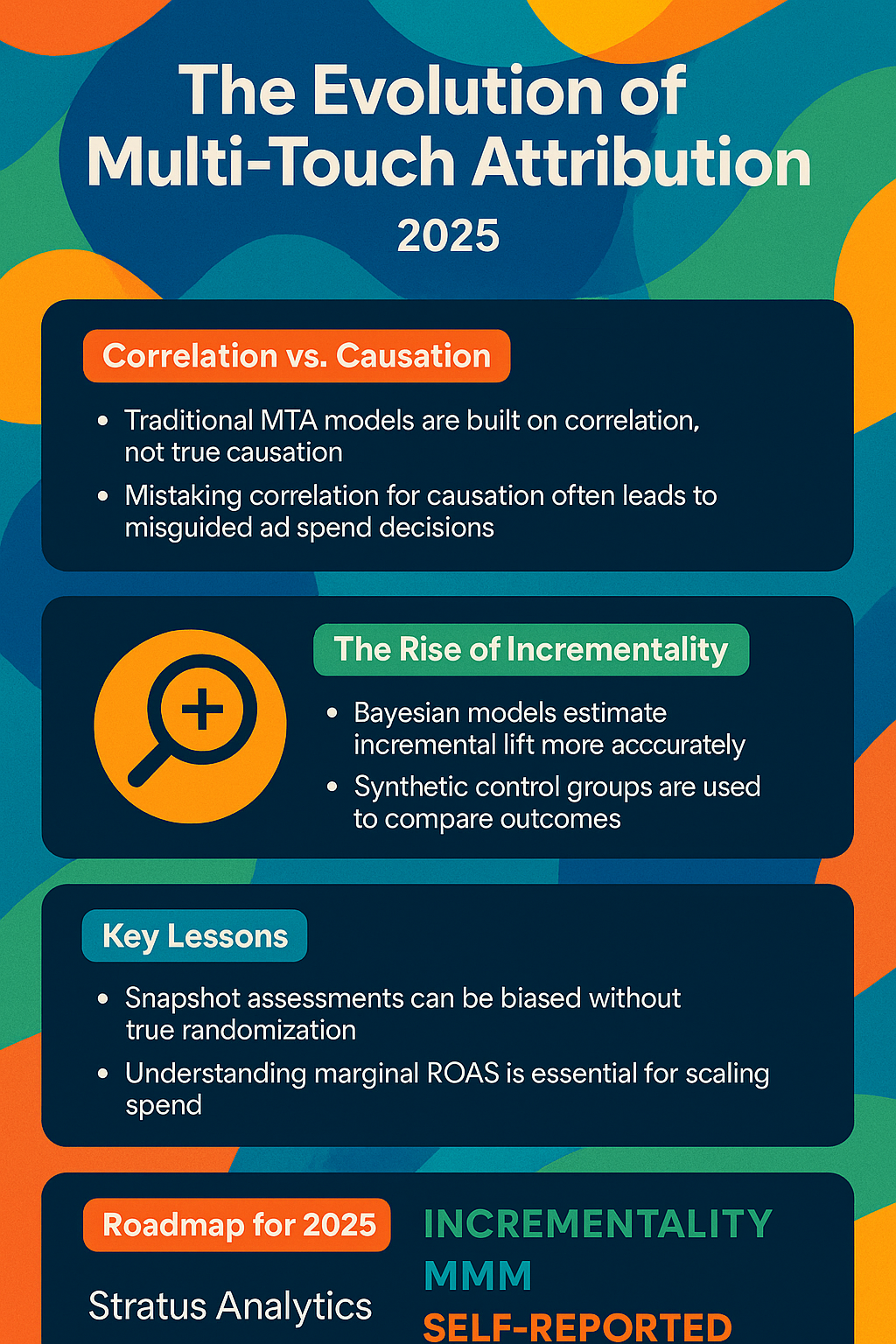For years, the dream of multi-touch attribution (MTA) shaped digital marketing strategy. Track every customer touchpoint, assign perfect credit across the funnel, and scale spend with total confidence. It was a vision of complete clarity—one where marketers could optimize every dollar to its highest and best use.
But if you have spent any real time working with actual data, you know the dream has always been elusive.
The deeper you dig into real-world marketing attribution, the harder it becomes to separate the truth from convenient illusions.
Today, Multi-Touch Attribution is not just struggling. It is collapsing into something even stranger, more probabilistic, and paradoxically, more useful—if you understand its limitations.
Why Multi-Touch Attribution Was Built on Fragile Assumptions
While some blame the decline of Multi-Touch Attribution on cookie loss, fragmented customer journeys, or stricter privacy laws, the deeper issue has always been structural.
Attribution models, at their core, are built on correlation—not causation.
When you view a dashboard or a traditional MTA tool, what you are seeing is a web of statistical correlations between actions and outcomes. Sometimes, those correlations align with true cause and effect. But often, they do not.
When you mistake correlation for causation, bad decisions follow:
- You scale spend based on surface-level patterns.
- You misattribute success to low-impact tactics.
- You fail to account for the true drivers of growth.
Most marketers have experienced this the hard way. You boost your ad spend by 20 percent based on attribution data—and your return on ad spend (ROAS) tanks. What looked predictable was actually a mirage.
The Rise of Incrementality and Synthetic Control Models
In response to the growing skepticism around traditional attribution, major platforms like Meta are rolling out new measurement approaches.
One major shift is the introduction of incremental attribution models.
Instead of simply reporting which clicks or impressions preceded a conversion, incremental attribution tries to estimate how much incremental lift was caused by your marketing activity compared to what would have happened anyway.
Under the hood, platforms like Meta are likely using Bayesian Structural Time Series (BSTS) methods. These models create synthetic control groups—counterfactual simulations of what results would have looked like without the ads running.
It is a meaningful step forward compared to last-click or even basic multi-touch attribution. However, it is important to recognize that BSTS models still have limitations:
- They can be biased by seasonality or external market shocks.
- Hidden variables (confounders) can skew results.
- Synthetic models are not substitutes for true randomization experiments.
Incrementality measurement moves the needle closer to causality, but it still lives in a world of probabilities, not certainties.
Why Measurement Must Adapt to the Customer Journey
Another key reality is that no single attribution model fits every business or every customer journey.
Working with large brands, we often see teams default to ultra-short attribution windows like 1-day click attribution inside Meta or Google Ads. Sometimes that is correct. If your buyer journey is fast and transactional, short windows capture the action.
However, in many cases—especially for higher-consideration purchases—short windows miss the real customer decision-making process. View-through conversions or longer attribution windows provide a truer picture of impact.
This is why scaling decisions based solely on platform defaults can be dangerous. Attribution must reflect reality, not assumption.
Proper holdout experiments—where one group is exposed to ads and another is not—remain the gold standard for validating what is truly moving the needle.
Three Lessons for Navigating the New World of Attribution
Based on working with clients through these shifts, here are three core principles every marketer needs to embrace:
1. Incrementality Studies Are a Snapshot, Not a Prediction
An incrementality test that shows a 3x iROAS today does not guarantee you can triple your ad spend tomorrow and maintain the same return.
Marketing effectiveness typically diminishes at higher levels of spend due to audience saturation, diminishing returns, and competitive pressures.
Use incrementality studies as diagnostic tools—not future projections.
2. Scaling Requires Measuring Marginal ROAS
Instead of treating ROAS as a single number, focus on marginal ROAS—the incremental return for each additional dollar spent.
Marginal ROAS usually declines as spend increases. Understanding this curve allows you to find the optimal spend level where profitability peaks before it begins to erode.
Blindly scaling based on average ROAS will almost always lead to disappointment.
3. Attribution Defaults Can Either Support or Sabotage Growth
Short-window attribution, long-window attribution, view-through conversions, or click-based models—each has a place.
The key is aligning your attribution framework with your actual buyer behavior.
Build flexible measurement strategies. When you notice a mismatch between attribution data and business outcomes, adjust your model, not your expectations.

The Future of Marketing Measurement
The future of marketing measurement will not be about finding a perfect attribution model. It will be about blending multiple perspectives to form a more resilient and adaptive strategy.
Marketers who succeed in 2025 and beyond will combine:
- Multi-Touch Attribution (MTA): For directional channel insights.
- Incrementality Testing: For understanding true lift.
- Marketing Mix Modeling (MMM): For broad, channel-level investment optimization.
- Self-Reported Attribution: For capturing real customer perspectives.
No single method is sufficient on its own. Each provides a lens that must be balanced against others to form a complete picture.
The real danger is not imperfect attribution—it is treating correlation as causation and scaling based on false confidence.
By recognizing attribution’s structural weaknesses and adapting your measurement strategies accordingly, you can make smarter, safer decisions and fuel sustainable growth even in an increasingly complex digital landscape.
Final Thoughts
Multi-Touch Attribution is not dead, but it is evolving.
It is becoming probabilistic, blended, and experiment-driven rather than deterministic and static.
Success in the new era of marketing measurement depends on humility—the humility to know that no model captures the full truth and that real-world experimentation is often the only way to know for sure.
When you embrace this mindset, you stop chasing the dream of perfect attribution and start building marketing systems that are resilient, adaptable, and grounded in reality.
Attribution confusion has stalled more growth than bad creative ever has.
In 2025, marketers who understand the difference between correlation and causation will be the ones who scale successfully.

Hi there! I’m Scott, and I am the principal consultant and thought leader behind Stratus Analytics. I have a Master of Science degree in marketing analytics, and I’ve have been providing freelance digital marketing services for over 20 years. Additionally, I have written several books on marketing which you can find here on Amazon or this website.
DISCLAIMER: Due to my work in the packaging industry, I cannot take on freelance clients within the packaging manufacturing space. I do not want to provide disservice to your vision or my employer. Thank you for understanding.
